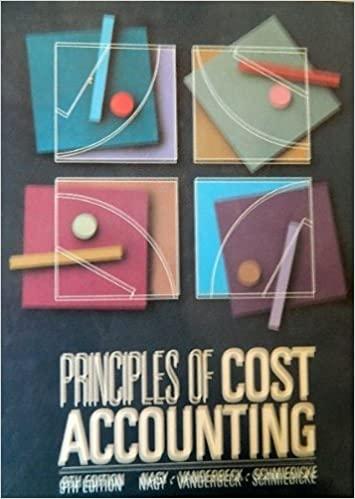Blossom Industrial Products Inc. (TIPI) is a diversified industrial-cleaner processing company. The company's Dargan plant produces two products: a table cleaner and a floor cleaner from a common set of chemical inputs (CDG). Each week, 855,000 ounces of chemical input are processed at a cost of $207,000 into 570,000 ounces of floor cleaner and 285,000 ounces of table cleaner. The floor cleaner has no market value until it is converted into a polish with the trade name Floor Shine. The additional processing costs for this conversion amount to $240,000. Floor Shine sells at $18 per 30-ounce bottle. The table cleaner can be sold for $17 per 25-ounce bottle. However, the table cleaner can be converted into two other products by adding 285,000 ounces of another compound (TCP) to the 285,000 ounces of table cleaner. This joint process will yield 285,000 ounces each of table stain remover (TSR) and table polish (TP). The additional processing costs for this process amount to $100,000. Both table products can be sold for $14 per 25-ounce bottle. The company decided not to process the table cleaner into TSR and TP based on the following analysis. Process Further Table Stain Remover (TSR) 285,000 $159,600 Table Cleaner 285,000 $193,800 Total Table Polish (TP) 285.000 $159,600 $319,200 Production in ounces Revenues Costs: CDG costs TCP costs Total costs Weekly gross pront 69.000 0 51.750 50,000 101.750 $57.850 51,750 50,000 101.750 $57,850 103,500 100.000 203,500 $115.700 69.000 $124.800 "If table cleaner is not processed further, it is allocated 1/3 of the $207,000 of CDG cost, which is equal to 1/3 of the total physical output. **If table cleaner is processed further, total physical output is 1.140,000 ounces. TSR and TP combined account for 50% of the total physical output and are each allocated 25% of the CDG cost Determine if management made the correct decision to not process the table cleaner further by doing the following (1) Calculate the company's total weekly gross profit assuming the table cleaner is not processed further. Total weekly gross profit $ (2) Calculate the company's total weekly gross profit assuming the table cleaner is processed further Total weekly gross profit $ (3) Compare the resulting net incomes and comment on management's decision Management made the decision by choosing to not process table cleaner further Using incremental analysis, determine if the table cleaner should be processed further. (Enter negative amounts using either a negative sign preceding the number eg. -45 or parentheses es. (451) Don't Process Process Net Income Table Cleaner Table Cleaner Increase Further Further (Decrease) Incremental revenue Incremental costs Totals Table cleaner bu processed urther Crane Fiber Company is the creator of Y-Go, a technology that weaves silver into its fabrics to kill bacteria and odor on clothing while managing heat. Y-Go has become very popular in undergarments for sports activities. Operating at capacity , the company can produce 1,090,000 Y-Go undergarments a year. The per unit and the total costs for an individual garment when the company operates at full capacity are as follows. Direct materials Direct labor Variable manufacturing overhead Fixed manufacturing overhead Variable selling expenses Totals Per Undergarment $1.94 0.59 1.07 1.46 0.32 $5.38 Total $2,114,600 643,100 1.166,300 1,591,400 348,800 $5.864.200 The U.S. Army has approached Crane Fiber and expressed an interest in purchasing 249,400 Y Go undergarments for soldiers in extremely warm climates. The Army would pay the unit cost for direct materials, direct labor and variable manufacturing overhead costs. In addition, the Army has agreed to pay an additional $1.01 per undergarment to cover all other costs and provide a profit, Presently Crane Fiber is operating at 70% capacity and does not have any other potential buyers for Y. Go. If Crane Fiber accepts the Army's offer, it will not incur any variable selling expenses related to this order











